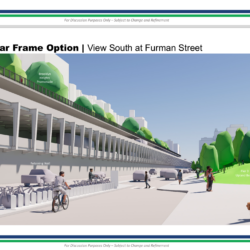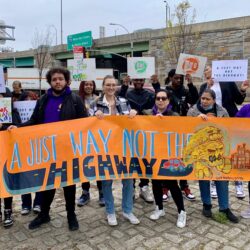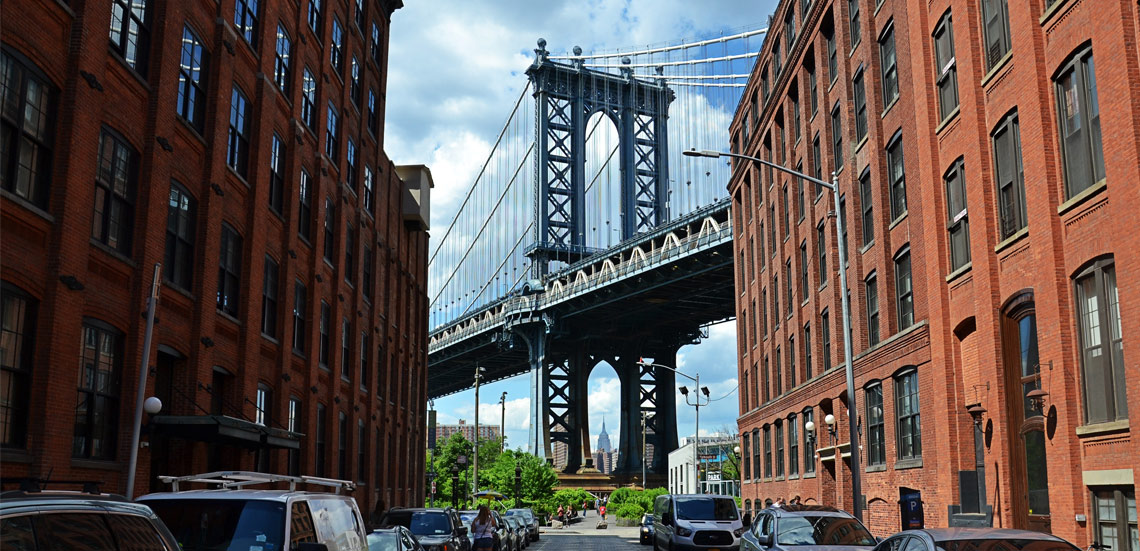
City releases report on fixes for BQE North and South
Coalition: No one mentioned the elephant in the room

The New York City Department of Transportation has released a 154-page report detailing dozens of concepts to improve the state-owned sections of the Brooklyn-Queens Expressway, known as BQE North and BQE South.
BQE North runs from the Kosciuszko Bridge to Sands Street, while BQE South runs from Atlantic Avenue to the Verrazano Bridge. (The city-owned BQE Central, between Atlantic Avenue and Sands Street, is undergoing a separate, contentious redesign process.)
At a press conference Wednesday, DOT said that the report — BQE North and South: Safe, Sustainable, Connected — explores ways to reconnect communities that were torn apart by the BQE when it was originally constructed, and ensures that there are safe, open and inviting spaces around the existing BQE infrastructure.

The expressway, which carries 150,000 vehicles a day, has divided neighborhoods like Williamsburg, Carroll Gardens and Sunset Park for almost 70 years, bringing dangerous pedestrian crossings, noise and pollution.
Deputy Mayor Meera Joshi and NYC DOT Commissioner Ydanis Rodriguez told reporters that the proposals would eventually help reconnect divided communities.
“It’s past time to dress the wounds of our city’s history and knit together communities long torn apart by Robert Moses-era infrastructure,” Joshi said.
Rodriguez said the measures will address safety, public space and connectivity for New Yorkers “who have been left out of the conversation around the BQE in the past.”

Major concepts
DOT’s report presents a range of concepts from simple streetscape and safety enhancements in Clinton Hill and Fort Greene; to more complex redesign of intersections in Red Hook; to building a green, park-like platform over the BQE trench (modeled on an idea originated as “BQGreen” roughly 14 years ago) in South Williamsburg.
It includes crossing improvements at West 9th Street, where the BQE divides Red Hook from Carroll Gardens and Gowanus — something the community lobbied hard for, DOT said.

In Sunset Park, DOT proposes “activating” the spaces under the elevated portions of the highway with activities like pop-up markets, local art exhibits or EV charging. (DOT says it will be scheduling additional regular cleanings where needed.) As a test run, DOT has been piloting an under-highway flea market called “BQ Flea” (operated by Brooklyn Flea) which opened Oct. 6 under the BQE in Williamsburg along Meeker Avenue.
Since the city doesn’t own BQE North and South, it can only make improvements on the streets and plazas near and under the highway, but not the highway itself.

A ‘roadmap,’ but no definite funds or timeline
In its report, DOT divides the proposals into near-, medium- and long-term. The “near-term” projects are doable as normal city operations, and in fact some have already begun, DOT says. These include painting, planters and safety upgrades, lighting, and activations like seating, public art, markets, freight microhubs, bike parking and more.
“Medium-term” projects could require some city-state coordination. They feature semi-permanent or concrete structures, like green infrastructure or sports facilities under the BQE.

DOT calls complex capital projects that need substantial construction “long-term” projects. These might include pedestrian bridges or the full/partial capping over the BQE, and would require a partnership with city, state and sometimes federal agencies to implement.
DOT’s more ambitious medium- and long-term proposals have no definite timeline or budget. However, DOT says it will use the report as a roadmap “to begin advancing concepts through further analysis and stakeholder engagement.”
NYC DOT and NYS DOT will further develop one complex capital project in BQE North and one in BQE South, funded by a $5.6 million federal Reconnecting Communities planning grant awarded in March of this year. The grant is expected to cover up to 30% of the design stage.

Coalition: The elephant in the room
DOT said the report was developed after extensive community outreach involving roughly 2,600 community members between 2022 and 2024.
Outside of DOT’s official process, however, members of a coalition of 17 community groups — the Brooklyn-Queens Expressway Environmental Justice Coalition (BQE EJC) — says that while they appreciate the city’s efforts to increase safety and usability near the BQE, the agency is missing the elephant in the room: the need for an end-to-end “corridor-wide vision” for the expressway.
“The Brooklyn Queens Expressway Environmental Justice Coalition reiterates its firm commitment to advocating to both City and State Departments of Transportation for a truly transformational approach to the BQE corridor,” BQE Coalition Organizer Maria Fernanda Pulido told the Brooklyn Eagle.
“Any BQE Plan must make tangible steps to comply with the State’s landmark climate bill: the Climate Leadership and Community Protection Act,” she said. Although the proposals aiming to enhance safety and the usability of streets and public spaces are essential, “they are only meaningful in the long-term if they are paired with a comprehensive plan” supported by the state and city DOTs that transforms the infrastructure along the entire corridor “to meaningfully reduce pollution and vehicle miles traveled, and center environmental justice.”

“We are in a moment in which our communities know intimately the impacts of the ongoing climate crises landing on our doorsteps. Therefore, we must take every step together and use this opportunity to rectify the well-known harms caused by the transportation planning of the last century,” Pulido added.
Daniela Castillo, director of the Green Light District at El Puente in South Williamsburg, said the organization was glad to see projects in the report “that begin to address many environmental and health burdens that our community of Los Sures has been facing.”
“We still wish to see commitment from both City and State DOT in pushing forward a comprehensive approach and transformative vision to this corridor that invests in alternative measures that make our communities healthier, safer, and less dependent on this infrastructure,” she said.

The environmental justice organization UPROSE, a member of BQE EJC, remains focused on advocating for a community-led vision rooted in environmental justice, UPROSE Communications Director Ngoc-Tran Vu told the Eagle.
“Any long-term success hinges on collaboration between city and state agencies,” she said. “We need a comprehensive plan that aligns with New York’s climate goals and reduces pollution and vehicle miles traveled along the entire corridor.”
In 2020, former Mayor Bill de Blasio’s 17-member BQE expert panel formally recommended a corridor-wide BQE approach. “Any new, corridor-wide vision needs to be grounded in today’s transportation and sustainability goals – minimizing growth in road traffic, maximizing public transit usage, providing alternatives for local freight, protecting the environment and promoting quality of life in adjacent communities,” the report said in part.

The City Council also favored “a corridor-wide vision” in its 2020 report, “The Future of the BQE.” And at the BQE 2053 symposium on Governors Island in May 2023, an overarching theme was the necessity of rethinking the entire BQE corridor as a whole, rather than in segments, as part of a sustainable, multi-modal transportation network.
Another member of the BQE EJC coalition, who didn’t want to be named, remarked that many of the near-term projects in the report fall within DOT’s normal portfolio of maintenance and upgrades. “DOT should be doing them anyway,” they said.
“We didn’t ask for vendors under the BQE in Sunset Park,” they said. “We are asking for a corridor-wide vision for transforming the BQE in collaboration with the city, state and federal government.”
Leave a Comment
Leave a Comment




